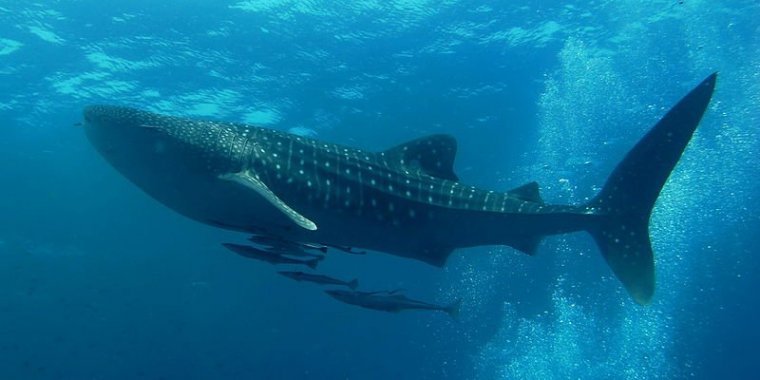| News / Science News |
New study of endangered whale shark youth shows vital habitat similarities
In findings published on Friday, researchers from the University of York and Maldives Whale Shark Research Programme have mapped key habitats of the world's largest fish, the whale shark, shedding light on congregation sites that have perplexed marine biologists.

Whale shark at the Andaman sea. ![]()
According to the researchers, Whale sharks, Rhincodon typus, listed as endangered under the IUCN Red List, do feed in the open ocean, but juveniles tend to form large groups in only about 20 to 25 specific places around the coasts of Mexico, Belize, the Maldives, and Australia, which previous research has not explained.
Results showed the sharks' frequented sites had areas of very shallow water near a steep drop-off into the depths, such as a shelf break or reef slope.
The whale shark can grow to eighteen metres (60 ft) in length. Unlike its better-known relatives, the Great white shark and other predatory sharks, the whale shark is a filter feeder, meaning that it draws water into its mouth and extracts small organisms from the liquid.
They can search for food at the surface of the ocean but are also known to dive deep. Sharks are ectotherms, which means they depend on external sources of body heat.
Because they may dive down to feed at depths of more than 1900 metres, where the water temperature can be as cold as four degrees, they need somewhere close by to rest and get their body temperature back up.
Steep slopes in the seabed also cause an upwelling of sea currents that stimulate plankton and small crustaceans such as krill that the whale sharks feed on.
Such sites are also attractive to fishing and recreational boating, and collisions can injure sharks. They are extremely valuable to local people on the coastlines where they gather, which are often in developing countries.
While a whale shark can be worth as much as $250,000 USD dead, alive it can provide more than $2 Million USD over the course of its life span. The latter figure specifically estimates only ecotourism. (Wikinews)
YOU MAY ALSO LIKE

